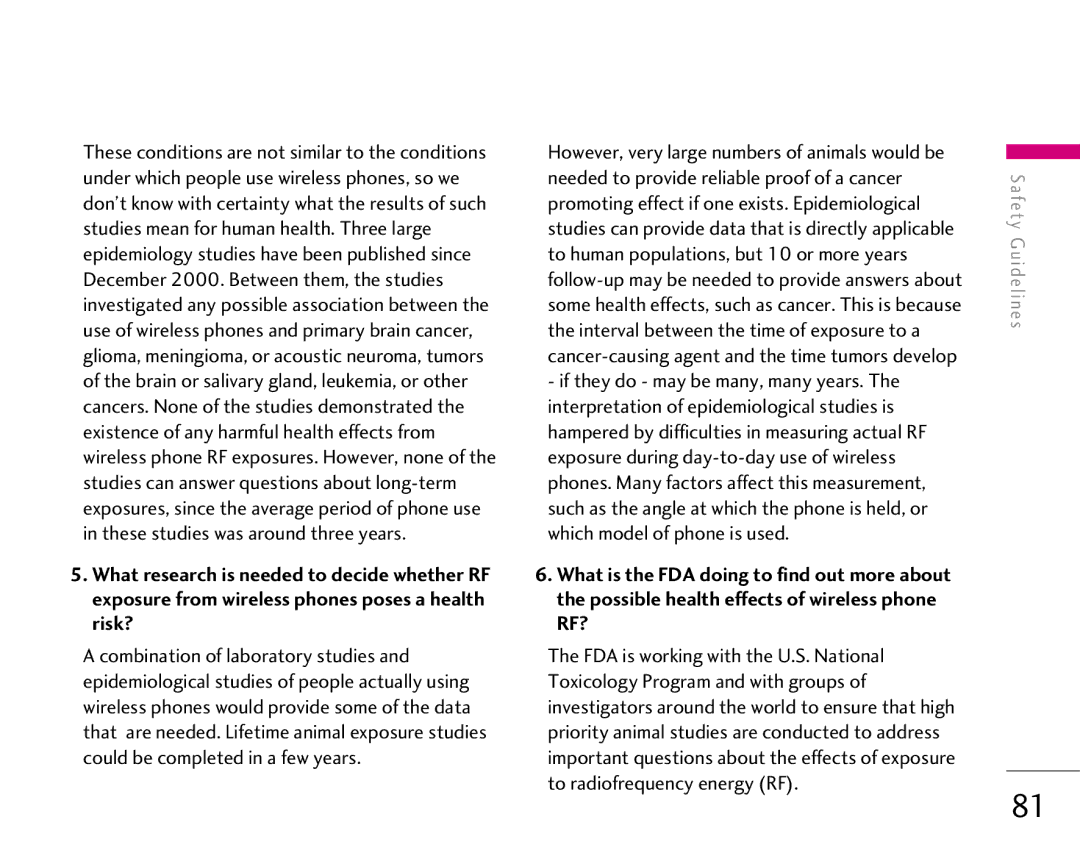LG1500 User Guide
Table of Contents
Write Message Inbox Outbox Sent Drafts Settings
Drafts Settings Delete All
Listen To Voice Mail Voice Mailbox Number
Inbox Receive
Table of Contents
Check to make sure that you have all the parts shown below
Unpacking
Safety Instructions
For Your Safety
Important Information
Before You Start
For Your Safety
FCC RF Exposure Information
For Your Safety
Body-worn Operation
Vehicle Mounted External Antenna optional, if available
Battery Disposal
FCC Part 15 Class B Compliance
Adapter Charger Cautions
Phone Components
Your Phone
Tools menu hot key For further details, see page 54~57
Earpiece
Message key Use to retrieve or send text messages
Sounds menu hot key For further details, see
Area Description
Your Phone
On-Screen Icons
Icon
Indicates the Schedule function
Services available and many others
Installing the SIM Card
If necessary, switch off the phone by holding down
Getting Started
Getting Started
Phone and invalidate your warranty
Charging the Battery
Getting Started
With the package
If the battery fails to charge completely
Access Codes
Key until the power-off image displays
Turning Your Phone On and Off
Making a Call
General Functions
Vibrate Mode Quick
Adjusting the Volume
Answering a Call
If the Flip Open menu optionMenu 9.3.2 is set
Entering Text
Changing the Text Input Mode
Using the T9 Mode
Key. The available modes are displayed
General Functions
Using the ABC Mode
Using the Symbol Mode
Using the 123 Numbers Mode
To access the available
Selecting Functions and Options
Menu Names
Address Book
During a Call
In-Call Menu
Multiparty or Conference Calls
Setting Up a Conference Call
Muting the Microphone
Activate the Conference Call on Hold
In-Call Menu
Private Call in a Conference Call
Ending a Conference Call
Games & Apps Bookmarks Information
Menu Tree
Tools
Prepaid
Messaging
Text Messages
Write Message Menu
Sent Menu
Forward Forwards the current message to other recipients
Messaging
This menu allows you to set up default SMS
GSM Preferred/GPRS Preferred
Allows you to delete all messages
Multimedia Messages
Message
Reply Allows you to reply to the sender
Message to other recipients
Sending of the failed message
Drafts Menu
Voice Mail
Listen To Voice Mail Menu
Auto Download
Templates
Download Messages
Voice Mailbox Number Menu
’m on the way
Send Via
Business Card Menu
Check Memory
Using the Phone Keys
Web Access
Using the WAP Browser Menu
Navigating with the WAP Browser
Home
Cache Settings
Bookmarks
Go To URL
Security Certificates
Web Access
WAP Information
List of the available certificates is shown
Within the Games & Apps menu
Games & Apps
Edit Selected bookmark can be edited. Editing a
Games & Apps
Input is necessary
No Favorites
Memory Status Menu
Information
Java Version Menu
Displays current Java version
Games & Apps
My Folder
Ringtones/Audio
Graphics
Multimedia Contents
Missed CallsMenu
Recent Calls
Dialed Calls
Received Calls
Delete Recent Calls
Call Duration
Data Information
External Device Menu
Recent Calls
CalendarMenu
Alarm Clock
Right/left navigation keys Press the left soft key Set
For changing the day, month, and year
Key Description
Tools
Calculator
Memo
Exit Editor Allows you to exit in memo editor Select a Memo
World Time
Unit Converter
Memo displayed
New Contact
Contact List
Address Book
Speed Dials
Adding new entries into SIM memory
Copy All
Caller Groups
SIM To Phone Menu
Phone To SIM Menu
SettingsMenu
Delete AllMenu
Set View Detail Menu
Allows you to display your phone number in the SIM card
Check Memory Menu
Sounds
Settings
Display
Ring Alert Type Menu
Backlight Menu
My Wallpaper Menu
Settings
Call Settings
Date & Time
Send My Number Menu
Answer Mode Menu
Call Waiting Menu
Minute Minder Menu
Security
Auto Redial Menu
PIN Code Request Menu
Fixed Dial Number FDN Menu
Connection
Change Codes Menu
World Phone Menu
Gprs Attach Menu
Reset Setting
Why does the LCD not turn on?
Page
Accessories
Standard battery is available
Connects your phone to a PC
Exposure to Radio Frequency Signal
Safety Guidelines
Antenna Care
Phone Operation
Safety Guidelines
Health Care Facilities
Other Medical Devices
Vehicles
Posted Facilities
Charger and Adapter Safety
Safety Information
Battery Information and Care
For Vehicles Equipped with an Air Bag
General Notice
Explosion, Shock, and Fire Hazards
Do wireless phones pose a health hazard?
Safety Guidelines
Update?
Stations operate at higher power than do
FDA and other federal health and safety
Document
Safety Guidelines
Electromagnetic Fields EMF Project since its
World Health Organization International
From experts in government, industry,
Users. The Crada will also include a broad
Safety Guidelines
Exists
Children be discouraged from using wireless
Teenagers. If you want to take steps to lower
Exposure to radiofrequency energy RF,
Where can I find additional information?
Driver Safety Tips
Let your voicemail answer it for you
Position your wireless phone within easy reach
Road
Not paying attention to the road or nearby
Consumer Information on SAR Specific Absorption Rate
Its highest certified power level in all tested
Lower the power output
Operate at multiple power levels to use only
Ability to reroute calls to another number
Glossary
Glossary
SDN Service Dial Number
Memo
Memo
